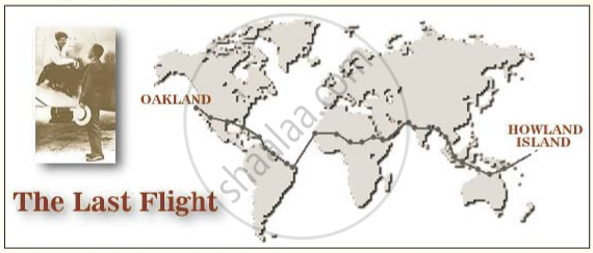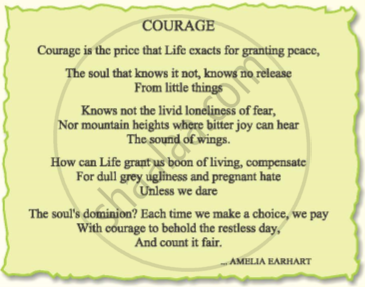Advertisements
Advertisements
प्रश्न
What was the real aim of Miss Beam’s school?
उत्तर
The real aim of Miss Beam’s school was not to teach so many subjects to make them thoughtful. They were trained to be kind to others and become responsible citizens. The school aimed at teaching ‘thoughtfulness’.
APPEARS IN
संबंधित प्रश्न
After you have made a choice do you always think about what might have been, or do you accept the reality?
How does Toto take a bath? Where has he learnt to do this? How does Toto almost boil himself alive?
This poem describes the journey of a stream from its place of origin to the river that it joins. The poem has been written in the form of an autobiography where the brook relates its experiences as it flows towards the river. In Literature such a device by which an inanimate object is made to appear as a living creature is called Personification. Just as the brook has been personified in this poem, write a poem on any inanimate object making it come alive. You could begin with a poem of 6-8 lines. The poem should have a message. Maintain a rhyme scheme. Try and include similes, metaphors, alliteration etc. to enhance the beauty of the poem. You could write a poem on objects such as the candle/a tree/a rock/the desert etc.
This could be given as a homework activity. The teacher could read out some of the poems in the class and display the others.
The world's most famous female aviator, Amelia Earhart, disappeared in 1937, as she attempted to become the first woman to fly around the world with her navigator, Fred Noonan. She was last heard when she was around 100 miles from the tiny Pacific Howland Island on July 2, 1937.
Read the story of her 'Final Flight'.
On June 1, 1937 Amelia and her navigator Fred Noonan departed from Miami, Florida; bound for California. Their first destination was San Juan, Puerto Rico; from there, skirting the northeast edge of South America; and then on to Africa and the Red Sea.
The flight to Karachi was another first. No one had previously flown non-stop from the Red Sea to India before. From Karachi, the Electra flew to Calcutta on June 17 from there on, to Rangoon, Bangkok, Singapore and Bandoeng.
The monsoon prevented departure from Bandoeng for several days. Repairs were made on some of the 'long distance' instruments which had given trouble previously. During this time, Amelia became ill, and suffered from dysentery that lasted several days.
It was June 27 before Amelia and Noonan were able to leave Bandoeng for Port Darwin, Australia. At Darwin, the direction finder was repaired, and the parachutes were packed and shipped home as they would be of no value over the Pacific .
Amelia reached Lae in New Guinea on June 29. At this point they had flown 22,000 miles and there were 7,000 more to go over the Pacific. Amelia cabled her last commissioned article to the Herald Tribune. Photos show her looking very tired and ill during her time at Lac.
The U.S. Coast Guard cutter, Itasca had been standing off Howland Island for some day to act as a radio contact for Amelia Radio communications in the area were very poor as Itasca was overwhelmed with commercial radio traffic that the flight had generated .

Amelie left Lae at preciaely 00:00 hours Greenwich Mean Time on July 2 . It is believed that the Electra was loaded with 1,000 gallons of fuel , allowing for 20-21 hours of flying .
At 07:20 hours GMT Amelia provided a position report placing the Electra on course as some 20 miles southwest of the Nukumanu Islands . The last weather report Amelia was known to have received was before take-off . The head wind speed had increased by 10-12 mph, but it is not known if she ever received the report.
At 08:00 GMT Amelia made her last radio contact with Lae . she reported being on course for Howland Island at 12,000 feet . There is no real evidence as to the precise track of the aircraft after Nukumanu . No one saw or heard the plane fly over .
Several short transmissions were received by the Itasca with varying signal strengths but they were unable to get a fix on her location because they were too brief. At 19:30 GMT the following transmission was received from the Electra at maximum strength.
"KHAQQ calling Itasca. We must be on you but cannot see you ... gas is running low ... "
At 20: 14 GMT, the Itasca received the last voice transmission from Amelia giving positioning data. The Itasca continued to transmit on all frequencies until 21:30 hours GMT. They determined that Amelia must have died at sea and began to implement search procedures.
It has been determined that the plane went down some 35-100 miles off the coast of Howland Island. A life raft was stowed on board but no trace was ever found of the raft. Some experts felt that the empty fuel tanks could keep the plane afloat for a period of time.
President Roosevelt authorized a search party of 9 naval ships and 66 aircrafts at an estimated cost of over $4 million. On July 18, the search was abandoned by ships in the Howland area. George continued to seek help in the search, but by October he too abandoned all hope of finding them alive.
Amelia had been sending letters to George at stopovers all along her route quite regularly. These were published in the book 'Last Flight'. The book has a note from her to George ....
"Please know I am quite aware of the hazards ... I want to do it because I want to do it. Women must try to do things as men have tried. If they fail, their failure must be, but a challenge to others. "

Amelia created a number of aviation records :
o The first woman to fly across the Atlantic in 1928
o The second person to fly solo across the Atlantic in 1932
o The first person to fly solo from Hawaii to California in 1935 Guided by her publicist and husband, George Putnam, she made headlines in an era when aviation had gripped the public's imagination.
Listen to an interview between a radio jockey and a pilot.
For oft, when on my couch I lie
In vacant or in pensive mood,
They flash upon that inward eye
Which is the bliss of solitude;
And then my heart with pleasure fills,
And dances with the daffodils.
Read the lines given above and answer the question that follow.
Explain with reference to context.
I was in for a surprise. When the time came for the broad-jump trials, I was startled to see a tall boy hitting the pit at almost 26 feet on his practice leaps! He turned out to be a German named Luz Long. 1 was told that Hitler hoped to win the jump with him. I guessed that if Long won, it would add some new support to the Nazis’ “master race” (Aryan superiority) theory. After all, I am a Negro. Angr about Hitler’s ways, 1 determined to go out there and really show Der Fuhrer and his master race who was superior and who wasn’t. An angry athlete is an athlete who will make mistakes, as any coach will tell you. I was no exception. On the first of my three qualifying jumps, I leaped from several inches beyond the takeoff board for a foul. On the second jump, I fouled even worse. “Did I come 3,000 miles for this?” I thought bitterly. “To foul out of the trials and make a fool of myself ?” Walking a few yards from the pit, 1 kicked disgustedly at the dirt.
Read the extract given below and answer the question that follow.
“Did I come all the way from America for this?” I thought bitterly. “To foul out of the trials and make a fool of myself?” What does this show?
What does ti» poet wish for al the end ~f the poem? What does tl1e poem tell the readers about the poet? Give a reason to justify yow· answer.
Why does the author call sleep a wonder?
What happens when the adults give too many instructions to their children?
Here are some points from a similar story that you might have heard in another language. Dividing the class into two groups try and tell the story in English. One person from each group can speak alternately. Your teacher will help you. As you tell it, one of you may write it down on the board.
A Mouse Maiden
l mouse changed into a girl by a magician...
l wants to marry the strongest person...
l asks whether sun or cloud stronger (why?)...
l but mountain stronger than clouds (how?)...
l but mouse stronger than mountain (how?)...
l girl asks to marry mouse, becomes a mouse again.
Multiple Choice Question:
When does the kite lose all its energy?
Multiple Choice Question:
How can a singer create beauty?
Answer the question.
What does he imagine about
what they do at home?
Answer the following question.
When Jumman’s aunt realised that she was not welcome in his house, what arrangement did she suggest?
Complete the following sentences from memory choosing a phrase from those given in brackets.
The first time I took a chance I got ____________
Why were the hinges of the door rusty?
Encircle the correct article.
Take (a/an/the) red one in (a/an/the) fruit bowl. You may take (a/an/the) orange also, if you like.
Which of the following words would best describe Abou Ben Adhem?
Referring closely to the short story, The Singing Lesson, show how the Headmistress’ summons to Miss Meadows eventually brings the latter out from cold despair to a realm of hope, love and joy.
